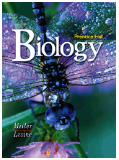In June 2003,
researchers announced the first successful cloning of an equine
when a baby mule named Idaho was presented
to the public. Click
here for a gallery of pictures showing Idaho and her foster
mom. The University of Idaho has a web
page with details of this achievement.
Dolly,
the first cloned mammal, died on February 14, 2003. Click
Here for a NYTimes article describing Dolly and her importance
to science.
On
December 27, 2002, the Raelians, an unusual religious sect, claimed
that the first cloned human baby had been born. New reports were
published by CNN,
BBC,
ABC,
and most major media.
Most scientists (including authors Ken Miller
and Joe Levine) now believe that these reports were nothing more
than an elaborate hoax.
A Scientific
American article published on November 25, 2001, carried the
first published claims of cloned human embryos.
A
discussion of the Ethical Issues associated with human cloning.
Theraputic
Cloning - How is it done? (Illustrations from Scientific American)
Cloning
and the Law. Even though Congress has banned human cloning in
government-sponsored research, it has placed no restrictions on
work done by private companies.
On
February 14, 2002, researchers from Texas A & M University announced
what is believed to be the first successful cloning of a cat. "CC,"
(Cloned Cat, shown at left) as she is known, was born to a surrogate
mother on December 22, 2001. She was produced from nucleus taken
from a adult cat's ovary (the egg donor is shown top left) and transplanted
into the cytoplasm of an egg cell from another cat. Click
Here for a press release from Texas A & M University describing
the research that led to CC's birth
Click
here for a link to an organization hoping to clone family pets such
as cats and dogs.



